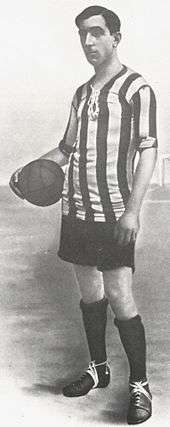Rafael Moreno Aranzadi
 | |||
| Personal information | |||
|---|---|---|---|
| Full name | Rafael Moreno Aranzadi | ||
| Date of birth | 23 May 1892 | ||
| Place of birth | Bilbao, Spain | ||
| Date of death | 1 March 1922 (aged 29) | ||
| Place of death | Bilbao, Spain | ||
| Height | 1.54 m (5 ft 1 in) | ||
| Playing position | Forward | ||
| Youth career | |||
| Escolapios | |||
| Senior career* | |||
| Years | Team | Apps | (Gls) |
| 1911–1921 | Athletic Bilbao | 17 | (10[1]) |
| National team | |||
| 1920 | Spain | 5 | (1) |
|
* Senior club appearances and goals counted for the domestic league only. | |||
| Medal record | ||
|---|---|---|
| Men's football | ||
| Representing | ||
| Olympic Games | ||
| | 1920 Antwerp | Team competition |
Rafael Moreno Aranzadi (23 May 1892 – 1 March 1922), known as Pichichi, was a Spanish footballer who played as a forward.
He played for Athletic Bilbao during the 1910s and 1920s.[2]
Club career
Born in Bilbao, Biscay, Pichichi played in his first Copa del Rey final in March 1913. Athletic Bilbao, his sole club, lost 0–1 against Racing Club de Irún. Later the same year, on 21 August, the same opponents, now renamed Real Unión, were invited to play the inaugural game at San Mamés Stadium, and he scored the very first goal at the new ground; he received his nickname because of his frail build.[3]
Pichichi subsequently played in five other domestic cup finals, winning four and netting a hat-trick in the 1915 final as Athletic beat RCD Español 5–0.[4] He died on 2 March 1922 at the age of only 29, victim of a sudden attack of typhus.[5][6]
International career
In 1920, Pichichi was a member of the very first Spanish national team that played at the Summer Olympic Games in Belgium. He gained five senior caps during one month, his debut coming on 28 August in a 1–0 win against Denmark.
Personal life
Pichichi's father was mayor of Bilbao,[6] and he was Miguel de Unamuno's nephew.[7]
In 1926, a bust was erected in his honour outside the San Mamés Stadium. It was tradition for teams visiting the ground for the first time pay homage by leaving a bouquet of flowers at its base.[8]
In 1953, Spanish sports newspaper Diario Marca introduced the Pichichi Trophy in his honour. It was awarded each year to the top scorers in La Liga and Segunda División.[9]
Pichichi was easily identifiable on the pitch due to a white cloth he tied to his head.[10] Both he and his future wife were immortalised in a painting by Aurelio Arteta.[11]
Honours
Club
- Copa del Rey: 1914, 1915, 1916, 1921
- Northern Championship: 1913–14, 1914–15, 1915–16
- Vizcayan Championship: 1919–20, 1920–21
Country
See also
References
- ↑ Goals scored in the Copa del Rey, which was the major national tournament in that era
- ↑ A LITTLE HISTORY: Rafael Moreno Aranzadi ‘Pichichi’; at Espangol
- ↑ "Rafael Moreno Aranzadi, más conocido por Pichichi" [Rafael Moreno Aranzadi, better known as Pichichi] (in Spanish). Marca. 6 February 2016. Retrieved 24 May 2016.
- ↑ "Spain – Cup 1915". RSSSF. Retrieved 24 May 2016.
- ↑ "Leyendas del Athletic Club de Bilbao – 'Pichichi'" [Athletic Club de Bilbao legends – 'Pichichi'] (in Spanish). El Correo. Retrieved 23 May 2016.
- 1 2 "Rafael Moreno, Pichichi, se convierte en mito (1922)" [Rafael Moreno, Pichichi, becomes a myth (1922)] (in Spanish). Diario AS. 1 March 2016. Retrieved 24 May 2016.
- ↑ "OPINIÓN: 'Pichichi', de Hugo a Chicharito" [OPINION: 'Pichichi', from Hugo to Chicharito] (in Spanish). Goal.com. 2 September 2014. Retrieved 24 May 2016.
- ↑ "El busto de Pichichi no encuentra su sitio en el nuevo San Mamés" [Pichichi's bust can not find its place at the new San Mamés] (in Spanish). ABC. 11 September 2013. Retrieved 24 May 2016.
- ↑ "Los discípulos de Pichichi" [Pichichi's disciples] (in Spanish). El Correo. 9 October 2015. Retrieved 11 February 2016.
- ↑ "Un poco de historia… Rafael Moreno Aranzadi "Pichichi"" [A little bit of history… Rafael Moreno Aranzadi "Pichichi"] (in Spanish). Orgullo Athleticzale. 12 May 2013. Retrieved 24 May 2016.
- ↑ "El Athletic comunica la baja a Felipe, Bordas y Escalona" [Athletic tells Felipe, Bordas and Escalona of decision to release them] (in Spanish). Diario AS. 31 May 2006. Retrieved 24 May 2016.
External links
- "Rafael Moreno Aranzadi". Olympics at Sports-Reference.com. Sports Reference LLC.
- Pichichi profile at BDFutbol
- Athletic Bilbao profile
- Pichichi at National-Football-Teams.com
- Pichichi – FIFA competition record
- Spain stats at Eu-Football